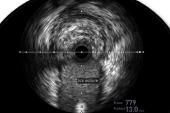Cardiac Deaths and Adverse Events After PCI Have Declined With Time
A comparison of RCTs from a recent 15-year period implicates multifactorial improvements, with some work still to be done.

There has been a significant reduction in cardiac death and PCI-related outcomes, including stent thrombosis (ST), over 15 years, suggests a large, systematic review of randomized clinical trials.
According to lead author Taku Asano, MD, PhD (St. Luke’s International University, Tokyo, Japan), the trends are likely related to a number of improvements, and taken together, they indicate that PCI outcomes are going “in the proper direction,” he told TCTMD in an email.
Commenting for TCTMD, Sripal Bangalore, MD (NYU Langone Medical Center, New York, NY), said the data reflect what many interventional cardiologists already know—that results in clinical trials have improved with time. And he questioned whether more evidence is even needed at this stage to prove that point. As for what is driving the improvements, he said that is less clear-cut.
“It could be that the differences they're seeing are being driven by differences in patient population or the treatment they received, and less to do with differences in stent technology. It's kind of convoluted and I think there are a long list of limitations, which the authors acknowledge,” Bangalore said.
Also commenting on the analysis, Davide Capodanno MD, PhD (University of Catania, Italy), said that while it’s true that it does not establish causal associations, there are likely multifactorial drivers.
“It's reassuring to know that the type of outcomes of these patients nowadays are better than 10 years ago,” he told TCTMD. Capodanno added that the lack of decline in MI may be attributed to progression of disease in segments that were not treated during the PCI.
“Perhaps one of the most important messages here is about medical therapy,” he said. “After appropriate PCI, we should do our best to utilize all of the standard-of-care options to minimize complications such as myocardial infarction and stent thrombosis.”
Trends Over Time
Published online ahead of print in EuroIntervention, the systematic review included a total of 66,327 patients from Europe, North and South America, East Asia, the Middle East, and Oceania. Overall, 12,510 patients received first-generation sirolimus-eluting Cypher (Cordis/Johnson & Johnson) or paclitaxel-eluting Taxus stents (Boston Scientific), and 53,817 received contemporary second-generation devices like zotarolimus-eluting Endeavor (Medtronic), everolimus-eluting Xience (Abbott), zotarolimus-eluting Resolute (Medtronic), and biolimus-eluting Nobori (Terumo).
The pooled incidence of 1-year cardiac death was 1.63% in 2003-2007, decreasing to 1.09% in 2013-2016. During those same periods, 5-year cardiac death also declined from 5.27% to 4.64%, as did 1-year TLR, which decreased from 4.32% to 2.55%.
Most notably, while there were no significant trends in 1-year ST rates, the 5-year rates declined significantly over the 10-year period (RR 0.18; 95% CI 0.07-0.44). Looking at the pooled data, the 5-year incidence of stent thrombosis declined from 2.8% in 2003-2007 to 1.2% in 2008-2012.
Asano and colleagues also observed that patient characteristic changed over time, with the mean age increasing by about 2 years over the 10-year period. Despite the decrease in cardiac death, noncardiac death showed an increasing trend. The authors say this likely reflects the older population and incidence with comorbidities due to aging.
Future Goals
To TCTMD, Asano said the sharp decline in stent thrombosis rates is likely to have a considerable impact on major endpoints.
“In the SIRTAX trial (n = 1,012), which is the oldest trial in our analysis, definite ST occurred in 49 patients, while MI occurred in 68 patients at 5 years. Thus, it is speculated that ST was a major factor [for] MI 15 years ago,” he said. “By contrast, in the BIOSCIENCE trial (n = 2,119), which is the latest trial reporting 5-year outcomes in our analysis, definite ST occurred in only 32 patients, while MI occurred in 217 patients at 5 years. Recently, ST has been a small part of MI factors. Of course, we should take into consideration that recent MI definition becomes more sensitive by applying troponin. But, I believe decreasing ST rate impacted on MI incidence, and subsequently impacted on cardiac death incidence.”
As for how PCI outcomes can be further improved, Asano noted that intravascular imaging in routine PCI, which has a low rate of use in US and European countries, potentially could further reduce rates of TLR and stent thrombosis if used regularly.
“The reduction in these events may in turn improve the major outcomes,” he said. “I believe that increasing the rate of intravascular imaging use in cath labs is a next challenge of PCI therapy.”
Bangalore agreed. “There will come a time where design changes in technology, such as making the struts thinner, will hit a plateau because we won’t be able to make them any thinner without paying a price,” he observed. “That's where optimizing your PCI technology is important. I'm very confident that it will further reduce events and late failure rates.”
As for the stents themselves, while the technology has improved dramatically, there is still more that can be done, Bangalore added.
L.A. McKeown is a Senior Medical Journalist for TCTMD, the Section Editor of CV Team Forum, and Senior Medical…
Read Full BioSources
Asano T, Ono M, Dai Z, et al. Temporal trends in clinical outcomes after percutaneous coronary intervention: a systematic review of 66,327 patients from 25 all-comers trials. EuroIntervention. 2021;Epub ahead of print.
Disclosures
- Asano reports no relevant conflicts of interest.
- Bangalore reports serving on advisory boards for Abbott Vascular and Biotronik.
- Capodanno reports speaker and consulting honoraria from AstraZeneca, Bayer, Boehringer Ingelheim, Daiichi-Sankyo, and Sanofi.





Comments